This is Richard, my guide on my exhilarating Walking Safari in our private area in Serengeti. He has company – Tsetse flies. I had their company as well - I was right behind him.
When on Safari, there are areas in the parks and conservation areas where you just can not avoid these pesky flies. Don't worry, they are not going to bother you all the time; they come only in certain areas.
A few things to help yourself.
Wear light-colored clothing.
These buggers are attracted to dark colors. If you can avoid dark blue and black clothing on Safari. You will notice clothes with this color hanging from trees in various areas, put there by the park officials, in hopes that these flies will be hanging out on those clothes instead of on you.
Try loose clothing.
Create a barrier between the fly and your skin. This is the best protection. And will keep you cool when hot. Win-Win.
Bug Spray.
This brand of spray has worked on me. At least kept a lot of them at bay, even when wearing black. Yup, I do wear that color on Safari as it is hard to get away from black clothing.
Anti-itch cream.
Relief for when those pesky flies do get in your vehicle. Put some anti-itch cream right away; it will help with the itch. And try to avoid scratching the sweet itch.
The silver lining here is that these flies keep the cows and humans away from the wildlife zones. They don’t seem to bother wildlife which means more areas for the wildlife to roam and the slow down of human encroachment. We are talking about tribes like the Maasai who live on the periphery of the Serengeti and Ngorongoro Conservation with their cows or the farmers with plantations close to Tarangire or Ruaha. Stay back, we need to give wildlife their space.
Keep Calm and Swat Away. Don't let them stop you from going on a Safari.













